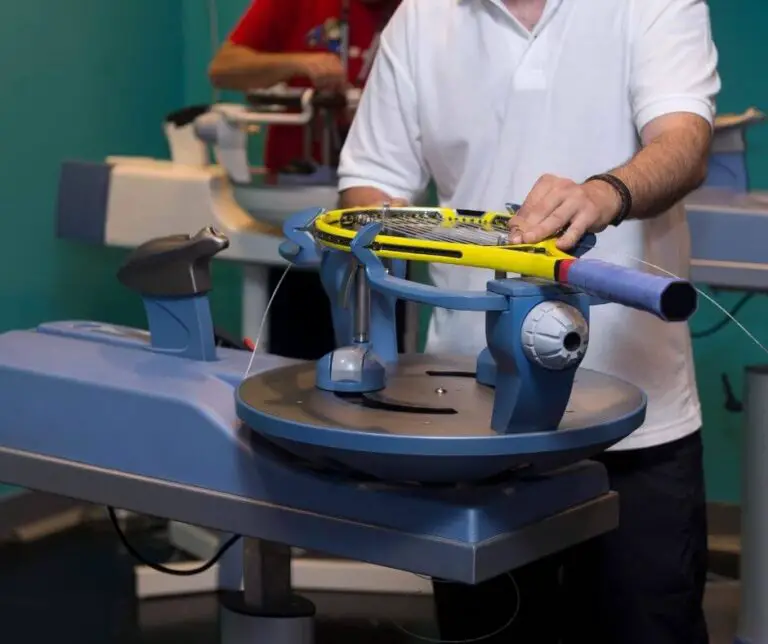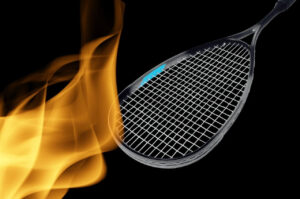Did you know that you can restring a tennis racket yourself? It’s a lot easier than you might think!
In this guide, we will walk you through the steps involved in restringing your tennis racket.
We’ll also provide some tips on how to choose the right string and tension for your needs.
So whether you’re a beginner or an experienced player, read on for all the information you need to know about restringing your tennis racket!
How often do you need to restring your tennis racket?
You should re-string your racquet every year just as often as you play per week.
For example, you should restring your tennis racket at least 3-4 times per year if you play 3-4 times a week.
This will help to ensure that the strings remain in good condition and provide optimal performance.
If you don’t play as often, you can get away with restringing your racket less often.

Can you string a tennis racket yourself?
You can, although it is recommended that you have your racket strung by a professional if possible.
However, if you play tennis several times a week, a stringing machine may be worth the money.
If you do decide to string your racket yourself, make sure you follow all the instructions carefully and take your time.
It’s also important to choose the right string and tension for your racket.
How do you restring a tennis racket?
1. Start by removing the old strings from your racket.
Use a cutting tool to carefully cut through the old strings near the top of the frame. Be careful not to damage the frame while doing this.
2. Once the old strings are removed, use a wire brush or other cleaning tool to remove any debris from the string bed.
This will help to ensure that the new strings can be properly installed.
3. Next, choose the type of string you want to use for your racket. There are a variety of options available, so be sure to select a string that is appropriate for your playing style and needs.
4. Once you have selected the string, it’s time to install it on the racket. Start by threading one end of the string through the top of the frame.
Then, use a needle or other sharp tool to guide the string through the rest of the frame.
Make sure that the string is tight and even as you go.
5. When you reach the bottom of the frame, it’s time to start tensioning the string. To do this, hold the string at the bottom of the frame and pull up on it until it is taut.
Then, use a clamping tool to secure the string in place.
6. Repeat this process with the other strings on the racket until all of them are installed and tensioned.
7. Once all the strings are in place, you can trim off any excess string that is hanging off the edges of the frame.
8. Finally, use a racket cover or other protective device to keep the strings from getting damaged when not in use.
Following these steps will help you restring your tennis racket properly so that you can enjoy the optimal performance on the court.
Remember to choose the right string and tension for your needs, and be sure to have your racket strung by a professional if possible.
With proper care and maintenance, your racket will provide you with years of enjoyment!
How do I know what tennis string is best for me?
Choosing the best tennis string for you can be tricky because there are many different types of strings on the market.
However, there are a few things you can keep in mind to help you make the right decision.
Consider your playing level, If you’re a beginner or intermediate, you’ll likely want to choose a string that is more forgiving and provides more power, like Natural gut and nylon strings.
On the other hand, if you’re an advanced player, you’ll probably want a string that is stiffer and provides more control, like polyester string.
Do tennis strings make a difference?
The type of tennis string you use can make a difference in your game.
Different types of strings offer different levels of power, control, and durability, so it’s important to choose a string that is appropriate for your playing level and needs.
Thinner strings have a higher tension and provide better playability, while thicker strings are stronger and last much longer.
Be sure to consult with a professional if you’re not sure which type of string is right for you.
What is the difference between the natural gut and synthetic gut string?
Natural gut tennis string is made from sheep intestine and is considered to be the best string for power and playability.
Gut strings have a more constant tension that remains longer than synthetic strings.
However, it is also the most expensive type of string on the market.
Synthetic gut tennis string is made from nylon or other synthetic materials and provides a good option for beginner and intermediate players.
It is not as expensive as natural gut string, but it does not provide the same level of power and playability.
How much does it cost to restring a tennis racket?
Generally, it will cost you anywhere from $15 to $75 to have your tennis racket restrung.
The average cost is around $40.
Per set of strings usually costs between $2 to $50.
Labor usually costs between $10 to $25 (per racket).
However, the exact price will depend on the type of string you choose and the professional you use.
Be sure to shop around and compare prices before having your racket restrung.
How do I know if my tennis racket needs to be restrung?
If your racket is losing power or spin, it’s a good indication that you need to restring it.
Other signs that you need to restring your racket include if the strings are fraying or breaking and if the tension feels off.
If you’re unsure whether or not your racket needs to be restrung, it’s always best to consult with a professional.
They will be able to take a look at your racket and determine if it needs to be restrung or not.
In conclusion
It’s important to keep your tennis racket in good condition so that you can enjoy the best possible performance on the court.
It is not so difficult to restring a tennis racket, but it is better to let someone experiment to avoid any costly mistakes.
If your racket is losing power or spin, or if the strings are fraying or breaking, it’s probably time to have it restrung.
Be sure to choose the right type of string for your playing level and needs, and be aware that different strings offer different levels of power, control, and durability.
Finally, keep in mind that it will generally cost you between $15 and $75 to have your racket restrung.
With proper care and maintenance, your racket will provide you with years of enjoyment!
We hope you enjoyed learning about how and when you should restring your tennis racket.
Do you have any questions or comments about how to restring the tennis racket? Let us know in the comments below!
We hope you enjoyed this comprehensive guide.
Thanks for reading! 🙂








